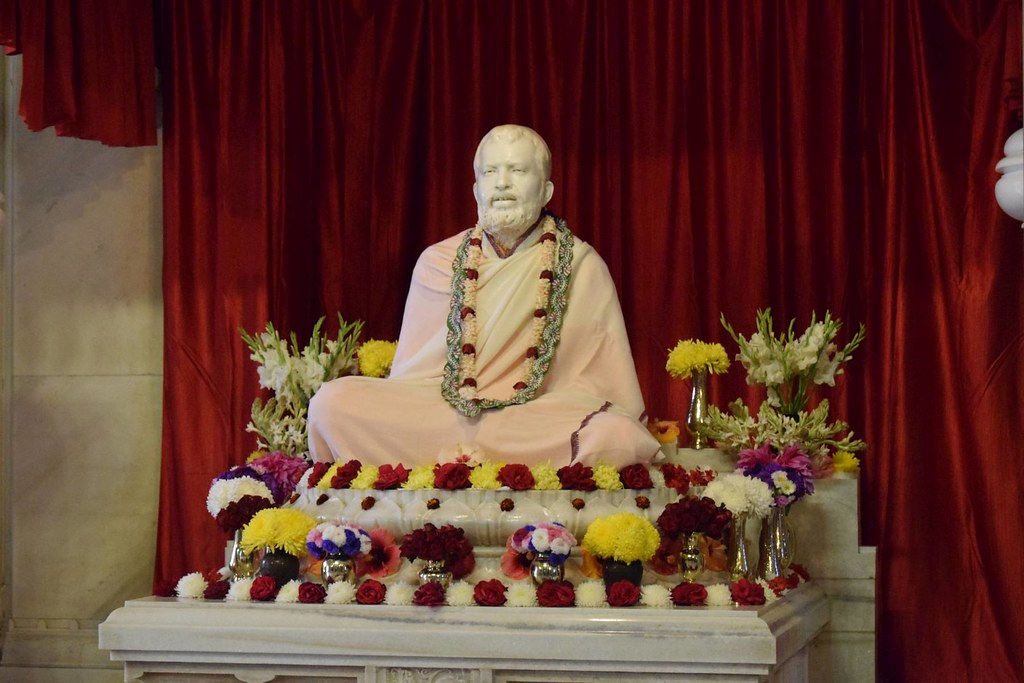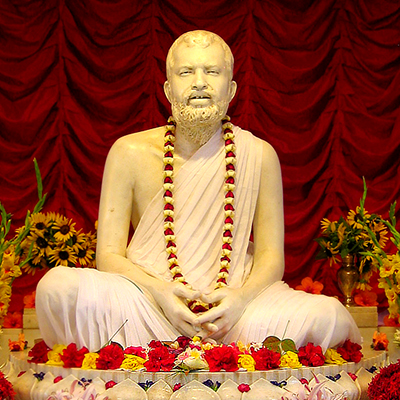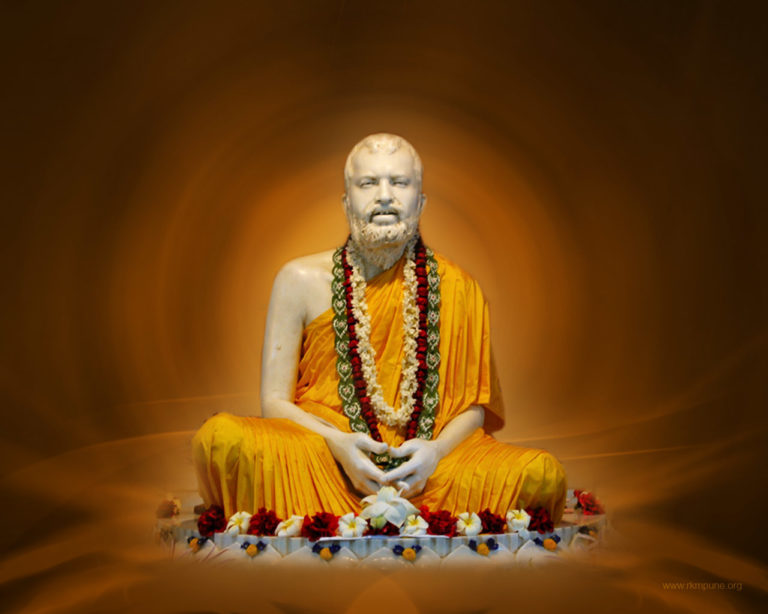(Continued from the previous issue…)
The third and fourth vidyas of the pilgrimage mindset practised by Sri Ramakrishna are presented in this issue.
This series on pilgrimage, presents pre-pilgrimage, pilgrimage, and post-pilgrimage mindset. The pilgrimage mindset consists of what the author calls four vidyas: 1) practice of tuning into the divine, 2) practice of spiritual association, 3) practice of the presence of the sacred, and 4) poking the honeycomb. The first two vidyas were discussed in the previous issue. This fourth article explores the last two vidyas.
The first two practices appeal to pilgrims whose temperament is either devotional or intellectual. But there is a third type of temperament. Some aspirants are inclined to see the Divine in nature, rather than in images or temples.
Vidya 3: Practice of the presence of the sacred
According to the disciples of Sri Ramakrishna, there are two ways to practice the presence of the sacred in places of pilgrimage. The first way is to see nature performing its own worship of the divine at the Virat or cosmic level. The second way is to experience the presence of divinity in nature itself.
The scriptures speak of nature worshipping Ishwara as Virat or the universal. The Mundaka Upanishad describes Ishwara as nature personified at the samasti or collective level:
अग्नीर्मूर्धा चक्षीषी चन्द्रसूर्यौ दिशः श्रोत्रे वाग्विवृताश्च वेदाः ।
वायुः प्रणो हृदयं विश्वमस्य पद्भ्यां पृथिवी होष सर्वभूतान्तरात्मा ॥
‘The heavens are His head; the sun and moon, His eyes; the quarters, His ears; the revealed Vedas, His speech; the wind is His breath; the universe, His heart. From His feet is produced the earth. He is, indeed, the inner Self of all beings.’ (2.1:4)
Swami Brahmananda, a mystic and a direct disciple of Sri Ramakrishna used to directly experience nature worshipping the Divine. Often he would gaze at the blossoming flowers in the garden and say, “Look, there you see the worship of God going on in His universal form.”1; “Those trees are worshipping the Cosmic God with their blossoms.”2
During her visits to Dakshineswar, Sister Nivedita would sit underneath the banyan tree, and experience nature worshipping the Divine at the cosmic level. In a letter to Sister Nivedita, Holy Mother affirms her experience of Nature worshipping the divine at the cosmic level: “He, the breath of the universe, is singing His own praise, and you are hearing that eternal song through things that will come to an end. The trees, the birds, the hills, and all are singing praise to the Lord. The banyan of Daksineswar sings of Kali to be sure, and blessed is he who has ears to hear it.”3
But should this worship of Nature not take place everywhere? Yes. It does take place everywhere. But it remains hidden or is only faintly expressed. It is palpable in places of pilgrimage because there is a special manifestation of God due to the “innumerable spiritual practices performed by perfected souls through the ages.”
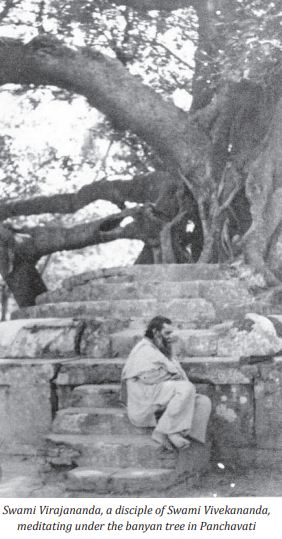
Great souls are able to perceive this divinity even in animals. Swami Brahmananda once said, “It is a great fortune to live at Dakshineswar even as a dog.”4 Once, when Sri Ramakrishna was walking towards the Panchavati, the forest-grove in Dakshineswar, to do tapasya, a dog began to follow him. Sri Ramakrishna stood still for a while watching the dog. He later explained, “The thought came to my mind that the Mother might say something to me through that dog.’5
This is an important lesson for spiritual aspirants: just as the temples and ghats become saturated with sattva, so does the soil of pilgrimage sites and even the creatures who live there. Therefore, as a pilgrim we should connect with the divine—not only in the images, temples and ghats, but also within the five elements – earth, water, fire, air, and space of the pilgrim sites.
On the eve of returning from his first visit to the West when an Englishman asked Swami Vivekananda how he felt about India, Swamiji replied: “Now the very dust of India has become holy to me, the very air is now to me holy; it is now the holy land, the place of pilgrimage, the Tirtha.”6
Sri Ramakrishna also beseeches spiritual aspirants to respect the subtle deity which pervades the holy land and waters, and to maintain the sanctity of the atmosphere and the land. As he was averse to ‘polluting any sacred land’, we should also refrain from either physically or mentally polluting the environment—either by throwing trash into the streets and rivers or by engaging in worldly talk. Earlier, we referred to Sri Ramakrishna’s anguish at hearing worldly talk of ‘lust and greed’ in places of pilgrimage.
However, Sri Ramakrishna’s experience of Lord Vishwanath was not restricted to temples, traditions, people, and customs. He also saw Him in living men, in local saints – which brings us to the fourth vidya of the pilgrimage mindset.
Vidya 4: Practice of ‘Poking the Honeycomb’
Holy company or the company of sadhus was highly encouraged by Sri Ramakrishna and his direct disciples. ‘Poking the honeycomb’ was an expression used by Sri Ramakrishna’s disciples to describe the process of extracting spiritual truths from perfected souls. In the Bhagavata, Sri Krishna explains the beneficial effect of associating with holy people: ‘The waters of holy rivers, or images made with clay and stone from a holy place, do not form a tirtha (holy place); these things take a long time to purify people. But, by virtue of God residing in their hearts, saints purify people by their mere sight.’7
The Kashi Khanda says that ‘those who dwell in Kashi take on the form, the attributes, and the ornaments of Rudra. [T]hey should be honoured as one would honour Rudra. [A]t death they are absorbed into Rudra-Shiva himself.’8
During his pilgrimage to Varanasi, Sri Ramakrishna literally experienced this truth. He went ‘several times to see Trailanga Swami, a leading paramahamsa in Kashi. The swami was then observing a vow of silence and staying at Manikarnika ghat.’9 Sri Ramakrishna said that he found in him ‘the living manifestation of Vishwanath’ and also that ‘Varanasi was sanctified and made vibrant by his presence.’10
But how should one approach a holy man?
In the Bhagavad Gita, Sri Krishna instructs Arjuna how to approach the wise and seek knowledge. He tells him, तद्विद्धि प्रणिपातेन परिप्रश्ने सेवया ।। “Know that by prostrating yourself, by questioning, and by offering service.” (4:34)
During his visit to Trailanga Swami, Sri Ramakrishna, although he himself was a realised Paramahamsa, followed these principles and approached the saint with humility, reverence, and an attitude of service. He later narrated, ‘I cooked rice pudding and brought it with me to feed him. At that time, he couldn’t speak to me because he had taken a vow of silence. So I asked him by signs whether God was one or many. He replied in the same manner, indicating God is known to be one when a person enters into the state of samadhi; but as long as there is any consciousness of I, you, jiva, and the world, God is perceived as many.’11
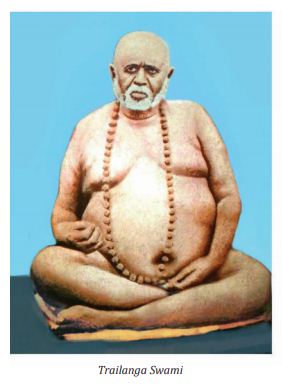
Understanding that association with holy people in places of pilgrimage will yield great spiritual benefit, Sri Ramakrishna also encouraged his devotees to visit sadhus and to ask questions which would increase their knowledge and devotion. At the same time, he strongly condemned finding fault in holy people, as this would be akin to polluting the environment.
For instance, a devotee named Manilal Mallick who had just returned from Varanasi came to visit Sri Ramakrishna. Sri Ramakrishna asked him about the holy people he had met during his pilgrimage. Manilal first described his encounter with Trailanga Swami: “Trailanga Swami is still in the same temple on Manikarnika Ghat with Benimadhav. People say that he was in a high spiritual state before. He could work any number of miracles. Now they are far fewer.” Sri Ramakrishna immediately dismissed this criticism of Trailanga Swami as “fault finding by worldly people.”12 Sri Ramakrishna then made further enquiries:
When we approach holy people
in places of pilgrimage, it is best to
ask practical questions related to
spiritual practice.
Sri Ramakrishna: Did you have any conversation with Bhaskarananda?
Manilal: Yes sir, we talked for a long time. Among other things, we discussed vice and virtue. He said: ‘Don’t tread the path of sin. Don’t even think of evil. This is what the Lord requires of you. Perform only actions which bring you merit.’
Sri Ramakrishna: Yes. That is true as far as worldly people are concerned. But it is different for those who are illumined, who have realised that only the Lord is the reality and all else is unreal and ephemeral. They know that the Lord alone does everything and that we are all non-doers. … And did you talk of anything else?
Manilal: I asked him how one could cultivate devotion and love for God. He said, ‘Repeat the Name. Say Rama, Rama.’
Sri Ramakrishna: That is very good. 13
We can infer from this dialogue that when we approach holy people in places of pilgrimage, it is best to ask practical questions related to spiritual practice. So Sri Ramakrishna encouraged spiritual aspirants to approach saints in places of pilgrimage in a humble manner—and, if possible, to serve them in some way. He himself had experienced that saints, for instance Trailanga Swami, who reside for many years in a holy place become living manifestations of its local deity
Sri Ramakrishna’s teachings on the postpilgrimage mindset, i.e., what a spiritual aspirant should do after completing the pilgrimage, will be discussed in the next issue.
References
1) The Eternal Companion. p. 118
2) A Guide to Spiritual Life. p. 38
3) Letters of Sister Nivedita. Vol.1, p. 359
4) Swami Brahmananda as We Saw Him, p. 39.
5) The Gospel of Sri Ramakrishna, p. 305.
6) The Complete Works of Swami Vivekananda. 3:309
7) Srimad Bhagavata 10:48:31, translated by Swami Tapasyananda
8) Kashi Khanda 30: 96-102
9) Sri Ramakrishna and His Divine Play, p. 612.
10) Ibid.
11) Ibid. p. 612.
12) The Gospel of Sri Ramakrishna, p. 201.
13) Ibid. pp. 201-202.
Once I was meditating in the Panchavati at noon while the Master was talking about the manifestation of Brahman as sound [Shabda-Brahman]. Listening to that discussion, even the birds in the Panchavati began to sing the Vedic songs and I heard them.
— Swami Brahmananda
Source : Vedanta Kesari, April, 2020
